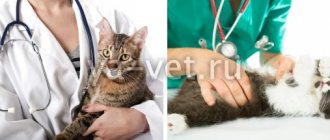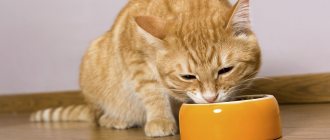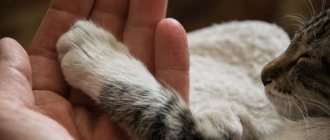Healthy cats are full of activity and appear cheerful. Any disease, even a minor one, always affects the behavior of the animal. An attentive owner will definitely notice alarming symptoms and seek medical help from a veterinary clinic.
- 2 What diseases do cats have
2.1 Video: skin diseases in cats
- 3.1 Table: common cat diseases and their characteristic symptoms
The first signs of disease
It is best not to allow the disease to occur at all, but if this turns out to be impossible and the cat is already developing some kind of pathology, the main thing is to notice the first symptoms - this will help to start treatment in a timely manner. The vast majority of diseases are easiest to treat at the very beginning. But there is a difficulty that prevents you from noticing health problems in time.
Cats, as a rule, try to hide their weakness, even from their beloved owners. This makes sense considering how felines have survived in the wild for millions of years. It was important for a lone predator to look strong and healthy both in front of fellow competitors and in front of potential enemies, so that no one would have the desire to challenge him. Therefore, cats have learned to hide pain or illness from prying eyes.
However, there is still a chance that your purr will let you know that you are not feeling well. If your cat meows frequently and loudly, it may well mean that she is trying to tell you about her illness (but it could also be explained by a hormonal peak - if the animal is not spayed or neutered, or even a simple attempt to attract attention, for example, to play ). Excessive nighttime activity of the pet (running around and/or meowing) may also indicate health problems - but, again, this is only one of the possible reasons.
If there are medical problems, the pet may also show aggression, especially if it touches an area that is bothering you. But sometimes aggression can seem outwardly unmotivated. What all these cases have in common is that the cat is trying with all its might to attract your attention. So if one of these forms of behavior is observed (constant meowing, nocturnal activity, aggression) coupled with at least some of the symptoms listed below, then the cat should be urgently shown to a veterinarian.
Symptoms can be divided into specific and nonspecific. Nonspecific, or general, symptoms accompany all, or at least most, diseases. Specific ones will be observed in a cat if it suffers from a specific disease or ailments associated with a specific system of the body (this includes, for example, diseases of the skin or gastrointestinal tract).
Cat diseases dangerous to humans
Pets have diseases that even humans need to be wary of. Therefore, take your cat to the veterinarian and monitor his health and appearance.
Rabies
The rabies virus, entering the blood of an animal, can cause death, but a more terrible option is when the animal can infect its owner, therefore, in order for the cat and the owner to be alive, it is necessary to get vaccinated on time.
The rabies virus can appear in a pet within a week or one year.
Symptoms
- Lethargy.
- Refusal of food.
- Photophobia.
- Attacks of aggression.
- The cat begins to chew everything in the house.
- Profuse salivation begins due to spasm of the larynx.
- Refusal of water.
- Paralysis.
In order to prevent the disease in time, you need to get vaccinated and after being bitten by another animal, go to a veterinary clinic.
Toxoplasmosis
A disease that affects cats, and due to its release into the general environment, people also become infected. The symptoms are similar to all other diseases, only at the height of the disease convulsions occur, thanks to which a correct diagnosis can be made.
It is impossible to cure toxoplasmosis, you can only restore the general condition of the cat.
Helminths
A very common disease, since parasite eggs are distributed everywhere, so it is very easy for your pet to become infected. Helminths are flat and round.
Causes:
- fleas;
- eating raw meat;
- transmission from animal to animal;
- transmission from mother to child.
Symptoms
- Vomit.
- Diarrhea.
- Constipation.
- Cough.
- Yellow color of mucous membranes.
- Rash.
- Paralysis.
- Fluid leakage into the peritoneum.
Very often, pets infect their owners, so comprehensive treatment must be carried out, both for the cat and for the owner, with special anthelmintic drugs.
Hemobartonosis
A disease in which the parasite invades the red blood cells of a pet.
Infection occurs after:
- childbirth;
- vaccinations;
- operations;
- stress.
Symptoms
- Fever.
- Dyspnea.
- Tachycardia.
- Refusal of food.
- Yellow color of mucous membranes.
- Fatigue.
It is important to treat the cat correctly and then you can quickly transfer the acute phase of the disease to the carrier phase. The pet will become a carrier of the disease.
Campylobacteriosis
A bacterium that causes enterocolitis in animals.
Causes:
- unsanitary conditions;
- weakened immune system;
Nonspecific (general) symptoms
Nonspecific symptoms in cats one way or another indicate the general poor condition of the animal. These include:
- Increased or decreased body temperature
A cat's normal body temperature is between 37.5 and 39ºC, with young cats closer to the upper limit and older cats closer to the lower limit. If the temperature goes beyond these limits, this is a reason to be wary even in the absence of other symptoms. When determining body temperature, you should not rely entirely on your nose. It is believed that a dry, warm nose in a cat is a sign of fever. However, it can be like this during sleep and even just in case of hot weather. The only guaranteed way to measure your temperature is to use a thermometer. But mercury thermometers are absolutely not suitable for cats (since there is a high probability that the cat will break it); only electronic and rectal thermometers are acceptable. An increased temperature is also indicated by increased breathing and heart rate (the normal cat's heart rate is 100-130 beats per minute), dilated pupils, intense thirst, and warming ears and fur.
— Decreased appetite
An adult (but not elderly) cat can go without food for up to three days, but this is the maximum. Then irreversible processes in the liver begin. Therefore, if the cat does not eat for the third day in a row, urgently take it to the veterinary clinic. In the case of kittens and older cats, this should be done already on the second day.
Of course, it is possible that the cat does not completely refuse food, but his appetite simply decreases. In any case, a sharp decrease in interest in food, weight loss (or, conversely, a sharp gain) should alert the owner.
Read about the reasons for refusing food or water: The cat does not eat or drink - what to do?
- Apathy, lethargy
A clear sign of illness is if a previously playful pet becomes lethargic, weak, does not want to move, and does not respond to the owner’s offer to play (for example, using a “fishing rod”). An even more obvious symptom is if the kitten hides in corners and in different secluded places and begins to be afraid of people. As soon as you notice this behavior, take him to the vet immediately.
Also, nonspecific symptoms of cat diseases include the following (although they are not observed in absolutely all cases):
— Hair problems
This could be hair loss, dullness, or the appearance of bald patches - all this indicates an imbalance in the cat’s body. Sores or peeling may be found on the skin.
— Vomiting and/or diarrhea
- Purulent discharge from the eyes, nose and ears.
How to understand that a cat is sick
A cat can get sick at any age. And also the development of pathologies does not depend on the breed of the animal. If your cat’s health deteriorates, the following general signs may be observed:
- lethargy of the animal;
- poor appetite;
- anxiety;
- sleep disturbance.
If a cat refuses a favorite treat, this should alert the owner
Symptoms of skin and coat diseases
If a cat is regularly outside unattended, then he has a high probability of contracting a skin or fur disease. In most cases, these diseases are caused by parasites: fleas, ticks, lice and lice. Pets are not completely protected from them (they can get into the apartment on the owner’s clothes or shoes), but the risk for them is still insignificant. This is one of the reasons why cats should not be left alone.
Read more about self-walking: Self-walking - when freedom means death
But it is quite easy to notice the symptoms of these diseases in cats. Cats, as a rule, show anxiety and nervousness, scratch a certain area of the body, often lick themselves as if biting themselves, bald spots, bald spots, small black spots appear on the fur, ulcers and various spots appear on the skin.
Infectious diseases
Infectious diseases are considered the most dangerous and difficult to treat. They, in turn, are divided into viral, bacterial and fungal. These diseases are numerous, have many subtypes, and their symptoms are different. But all are characterized by strongly expressed nonspecific symptoms (high fever, refusal to eat, weakness and apathy, vomiting, diarrhea). Among the specific ones, fever, whitening of the oral mucosa, and runny nose are often encountered. In case of infectious diseases, it is very important to consult an experienced doctor as soon as possible. Sometimes the life of a pet depends on the timeliness of treatment.
It is better not to treat viral diseases, but to prevent them, especially since some of them (for example, rabies) are incurable. But annual vaccination can dramatically reduce unnecessary risks. That's why all adoption wards are vaccinated. Don't risk the life and health of your pets!
Read more: What types of vaccinations are there for cats and why are they needed?
Prevention
To reduce the risk of developing diseases in your beloved pets, follow these recommendations:
- Visit your veterinarian regularly for preventative medical examinations;
- Make sure your cat's diet is balanced;
- do not allow the animal to become obese;
- To prevent worms, do not use raw meat and fish in your cat’s diet. When feeding your animal dry food, pay attention to the expiration date of the food product;
- Do not refuse mandatory vaccinations for cats. For example, you can only protect yourself from rabies through vaccination.
Vaccination will help protect your pet from dangerous diseases.
The outcome of any cat disease primarily depends on the competent actions of the owner: if any pathological signs appear in the animal, you should consult a specialist.
Eye diseases
Symptoms of eye diseases are clearly visible by external signs:
- profuse purulent discharge and lacrimation;
- photophobia;
- swelling and redness of the eyelids;
- clouding of the lens;
- protrusion of the eyeball.
The most common eye diseases in cats are glaucoma, conjunctivitis, cataracts, inflammation and wounds of the cornea. If the problem is not diagnosed and treated in time, the cat may go blind. Do not under any circumstances try to self-medicate with the help of so-called. "folk remedies".
Read more about this: Is treating cats with “folk remedies” effective?
Respiratory diseases in cats and cats
Let's look at the most popular ones.
Asthma
Bronchial asthma is manifested by muscle spasms and narrowing of the lumens of the bronchi. Most often, asthma occurs due to an allergic reaction, which can be caused by both dust and food.
The cat begins to thrash and gasp, wheezing or whistling appears, the animal tries to stretch its body upward to make air access possible.
Pulmonary edema
Occurs as a result of improper or untimely treatment; fluid collects in the lungs, which prevents the pet from breathing normally.
Manifestation:
- dyspnea;
- anxiety;
- breathing occurs abdominally;
- mucous membranes become blue due to lack of oxygen;
- the cat takes the same poses for several days;
- coughing;
- wheezing.
Cough
Most often, coughing occurs when the pet is in normal condition, as he is trying to regurgitate a hairball, but if wheezing occurs and the cat begins to meow heavily, you need to consult a veterinarian.
Runny nose
It appears due to inflammation of the nasal mucosa.
Manifestations:
- sneezing;
- breathing occurs through the mouth;
- discharge;
- The cat rubs its nose with its paws.
Rhinitis can also manifest itself due to a foreign body, so in order to prevent the death of your pet, it is necessary to take it to a veterinary clinic as soon as possible.
Calcevirus infection
Most often, kittens get sick; the infection is transmitted through saliva.
Manifests:
- high temperature;
- lethargy;
- the appearance of ulcers on the oral mucosa;
- profuse salivation.
A runny nose and watery eyes may also appear.
Inhalation
Ear diseases
The main problem associated with ears is ear mites. You should be concerned if your cat shakes his head frequently. The formation of a dark brown plaque in the area of the ears is also characteristic. In addition to ear parasites, cats often have otitis media, eczema, and hematomas. Specific symptoms in this case will be: severe itching, irritability of the cat (it will react very aggressively to attempts to touch the sore ear), as well as sulfur, purulent and bloody discharge from the ears.
Character of bowel movements
In order to notice changes in the nature of feces and urine, you need to know what they should be normally in a cat. Feces may vary slightly in consistency and color (depending on the type of feeding). But in any case, feces should be formed, the color should be from light brown to dark brown, without a strong odor.
In sick cats, the stool may be too loose (diarrhea) or too dry (dehydration, constipation), and the color may range from light gray to black. The smell of feces in some diseases can be extremely unpleasant and very pungent.
A cat’s urine should normally be transparent, yellow, with a specific odor, without foreign inclusions (traces of blood, “sand”, etc.).
Diseases of the genitourinary system
Diseases of the genitourinary system, unfortunately, are very common. Most often, their cause lies in an incorrect diet - cheap food, food from the human table (cats and I have different metabolisms, so foods that suit us are harmful to them), etc. Also, these diseases (especially the most common - urolithiasis) are promoted by obesity and a sedentary lifestyle.
Read about food “from the table”: Natural food for cats: benefit or harm?
Specific symptoms include:
- disturbance of normal urination (from frequent to complete absence);
- pain when trying to go to the toilet (manifests, for example, in frequent and loud meows);
- blood in urine;
- strong thirst.
If this disease is neglected, the consequences can be severe, even death.
Wounds and injuries
Unfortunately, this is not such a rare occurrence for cats, especially if they are allowed to walk outside. Of course, serious wounds or injuries are difficult to miss, but some - bites, bruises, scratches, cuts - may be more hidden, and they will not only cause discomfort to your pet, but also increase the risk of secondary infection. They can be identified by the following signs: bleeding, changes in gait, limping, purulent discharge in some places, bald spots on the fur, anxiety, reluctance to let the owner near any part of the body. Even if the wound is small, it is better to immediately contact the clinic, since there is no guarantee that the wound has not been infected.
Read more: How to treat wounds on a cat
Diseases of the nervous system in cats and kittens
Let's look at the most common variations of such ailments.
Epilepsy
These are convulsive seizures that occur as a result of damage to the pet’s nervous system.
Causes:
- head injuries;
- infections;
- toxic poisoning;
- stress;
- inflammation of the brain;
- frequent hypoxia;
- brain cancer.
Symptoms
- Cramps.
- The cat cannot find a comfortable position.
- Hoarse breathing.
- Increased heart rate.
- Foam from the mouth.
- Uncontrollable urination.
- Loss of consciousness.
Seizures can occur several times a day or more often; it is necessary to contact a veterinary clinic to save your pet’s life.
Veterinarian help
Central nervous system diseases
Diseases of the central nervous system are relatively rare in cats (with the exception of rabies, which, although it affects the nervous system, is still of a viral nature), but they cannot be ignored. The following symptoms will indicate diseases of this group: aggression, changes in habitual behavior (excessive activity is replaced by lethargy and apathy), convulsions, lack of coordination, paresis (partial loss of motor function) and paralysis. Although such pathologies are rare, they are extremely dangerous and must be noticed at an early stage, otherwise the likelihood of death becomes too great.
Oncology
It must be said that cats suffer from tumors less often than other pets. However, the tumors that appear in them are usually malignant. Cancer is 3-4 times more common in cats than in dogs. Tumors can arise in almost any tissue of the body. Their presence is signaled by: an unpleasant odor from the mouth, diarrhea, nausea, apathy, constant drowsiness, loss of appetite, sudden lameness, a change in habitual behavior (the animal does not allow itself to be picked up, breaks out, tries to hide), the appearance of lumps under the skin (or growths). on it). As in the previous case, the effectiveness of treatment depends on the stage at which the problem was discovered.
Read more about this: Tumors in cats and their removal
Thus, there are many possible diseases in cats; they affect a variety of body systems. Therefore, only a specialist can make an accurate diagnosis. But there are some common signs that are characteristic of most diseases. If you notice symptoms in a kitten such as fever, refusal to eat, apathy, vomiting, diarrhea, then even in the absence of other signs, urgently take him to the clinic or call a doctor at home.
“Murkosha” also reminds you of the need for routine examinations by a veterinarian: adult pets should be checked at least once a year, elderly pets – 2-3 times a year. If you follow all the recommendations, pay attention to preventive measures, and do not let diseases develop if they do occur, then your pet will be guaranteed a long healthy life!
Gastrointestinal diseases in cats
Liver lipidosis often occurs; due to a malfunction in the liver, fat begins to accumulate in the cells, which first provokes a decrease in the functions of the organ, and then leads to a complete loss of its function.
Causes of liver lipidosis:
- infections;
- oncology;
- toxic poisoning.
Most often found in sedentary cats, which are often transmitted.
Symptoms:
- outwardly the cat becomes more mature;
- loses weight;
- vomiting appears;
- lethargy;
- profuse salivation.
Volvulus
Occurs due to refraction of the mesenteries between the stomach and esophagus, as a result of which blood access is blocked, organ tissues die.
Causes:
- tumor;
- active lifestyle;
- injury or blow;
- endocrine system disruption;
- foreign bodies;
- worms.
Symptoms of the disease:
- meow;
- anxiety;
- refusal of food;
- vomit;
- painful stomach;
- constipation;
- weight loss.
Diarrhea
Diarrhea is defined as an animal defecating more than 7 times a day.
Diarrhea is distinguished:
- liquid;
- watery;
- mushy.
Causes.
- Infection.
- Stress.
- Allergy.
- Unbalanced diet.
- Frequent overeating.
- Poisoning.
Cat examination
Stomach ulcer
A stomach ulcer is the appearance of ulcers on the mucous membranes of the stomach and germination into them.
Reasons for appearance:
- unbalanced diet or food from the owners’ table;
- stress;
- medications;
- foreign bodies.
Symptoms.
- Lethargy.
- Vomit.
- Constipation or diarrhea.
- Weight loss.
- Unpleasant odor from the mouth.
Cholangitis
The process by which the bile ducts become inflamed can also inflame the liver and intestines. The cause is believed to be bacterial infection entering the organs.
Symptoms:
- vomit;
- diarrhea;
- yellowness of the mucous membranes and skin;
- fast weight loss.
Gastritis
Gastritis is manifested by inflammation of the stomach. Causes:
- Poor quality food.
- Mixing feed.
- Overfeeding.
- Change of food.
Symptoms.
- Reducing food intake.
- Lethargy.
- Unpleasant odor from the mouth.
- Vomit.
- Weight loss.
- Changes in the brightness and elasticity of the coat.
Pancreatitis
This is an inflammation of the pancreas. The reasons for the appearance may be:
- poor nutrition;
- diabetes;
- cancer;
- toxoplasmosis;
- poisoning;
- medications.
Symptoms of the disease.
- Vomit.
- Painful sensations, the cat screams loudly.
- Abdominal pain when palpated.
- Dehydration.
- Constipation or diarrhea.
- Lethargy.
- Coloration of mucous membranes yellow.
Constipation
This is a condition when a cat cannot recover on its own for a long time.
Causes:
- poor diet, lack of water;
- swallowed a large amount of wool;
- a foreign body interferes with the passage of feces;
- helminths;
- stress.
Symptoms.
- The cat is rushing about.
- Passes small dry feces.
- Screams during bowel movements.
If the cat cannot recover for a long time, seek help from a veterinarian.
Cirrhosis of the liver
Occurs due to the proliferation of parenchymal tissue, so the normal functioning of the liver stops.
Causes:
- hepatitis;
- avitaminosis;
- metabolic disease.
Symptoms
The animal feels good for a long time, since the disease begins gradually, when the pet becomes lethargic, fluid appears in the abdominal cavity, most often this is already a long and protracted disease process.









